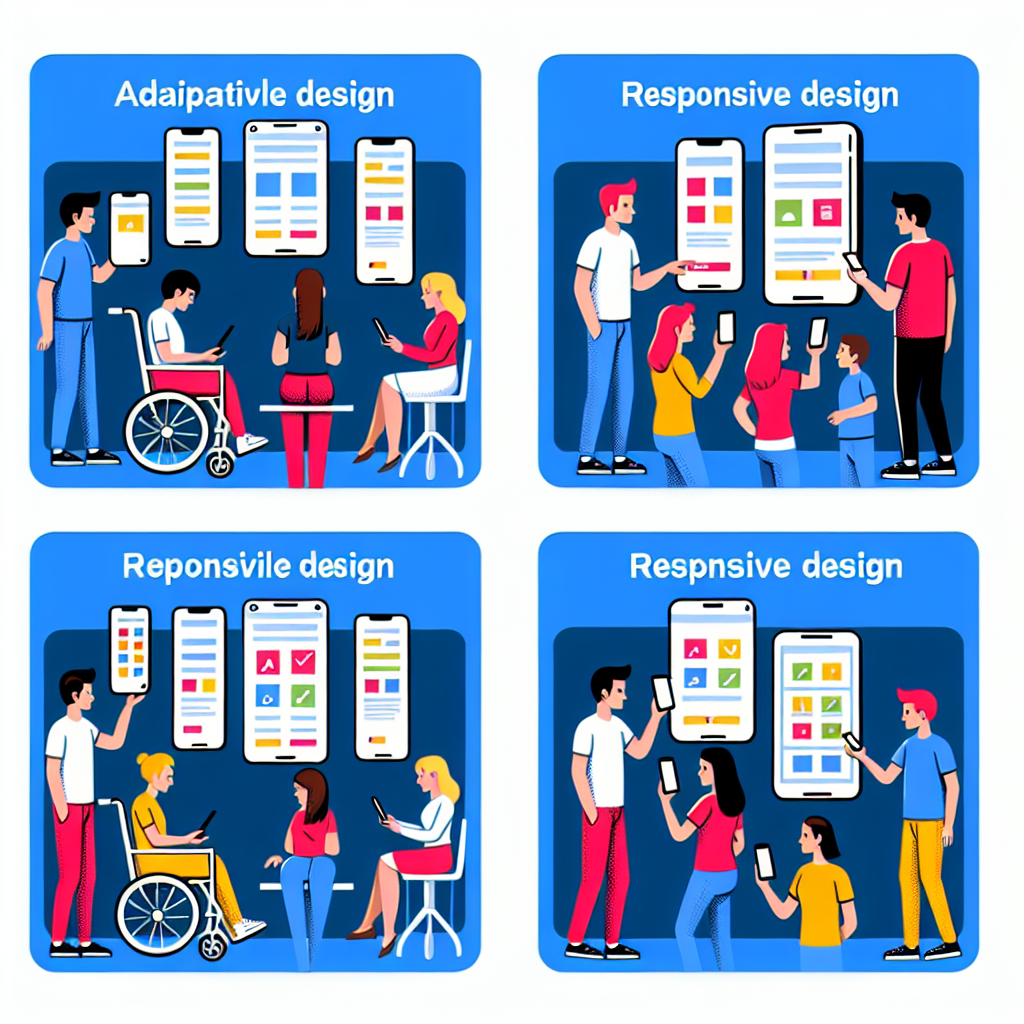Adaptive Designs: Understanding Differences, Advantages, and Examples
What Does Adaptive Design Mean? Understanding the Core Concept for Effective Web Solutions

When we talk about adaptive design, we’re diving into a world where technology meets user needs in a smart, tailored way. But what does adaptive design mean exactly? Imagine you’re using your smartphone, tablet, or laptop. How does a website know what device you’re using and adjust automatically? That’s the magic of adaptive design! It optimizes your browsing experience, ensuring that content looks great and functions perfectly regardless of the platform.
Adaptive Design Explained
Adaptive design is a technique that creates multiple versions of a website tailored to different screen sizes and resolutions. Unlike responsive design, which fluidly adapts to any screen on-the-fly, adaptive design actively recognizes the user’s device and serves the best-suited layout. This means faster load times and a clearer, more focused user experience.
- ⭐ Mobile Devices: You get a streamlined, touch-friendly version of the site.
- ⭐ Laptops: Accessible features that utilize the screens full width.
- ⭐ Desktops: Full layouts that embrace larger displays.
In fact, studies show that adaptive web design can lead to a 50% boost in user engagement because it reduces the friction often present when navigating a site that is not optimized correctly. Another striking statistic is that websites built using adaptive design show a 30% drop in bounce rates, as users find what they need without delays!
Real-Life Scenarios Recognizing Adaptive Design
Let’s clarify this with a couple of relatable scenarios. Imagine you’re a busy professional, always on the go. You might quickly check your favorite online store using your smartphone during a coffee break. If that store employs adaptive design, you’ll see a visually pleasing version tailored for your phone, making it easy to find and purchase the latest gadget you want. ⭐
Now, consider your grandmother who loves browsing the web on her tablet. If she visits a website that uses adaptive design, she’ll be greeted with larger buttons and simplified navigation, which is much easier for her to use. Your grandmother can shop or read articles without straining her eyes! ⭐
Examples of Adaptive Design in Action
Want to see adaptive design in action? Let’s look at some prominent examples:
| Website | Adaptive Feature |
| Spotify | Streamlined mobile version with easy navigation and access to playlists. |
| Wikipedia | Designed for readability on phones, tablets, and desktops, providing user-friendly formatting. |
| Amazon | Adaptive layouts that optimize product images and descriptions based on the device used. |
| BBC | News articles formatted differently for optimal reading across all devices. |
| eBay | Mobile version designed for quick bidding and browsing. |
| Distinctly tailored layouts enhancing user engagement based on device. | |
| Content streamlined for quick updates, readable on all platforms. | |
| Professional layout that adapts to users devices for networking on-the-go. | |
| Netflix | User-friendly interface that adapts to small or large screens while maintaining visual appeal. |
| New York Times | Visual storytelling optimized for different devices, providing an engaging reading experience. |
These are just a few examples of adaptive design smoothing the browsing experience for every user. Whether youre shopping online, reading the news, or streaming your favorite show, adaptive design plays a crucial role in delivering content effectively.
Why Choose Zuniweb Studio for Your Adaptive Design Needs?
At Zuniweb Studio, we specialize in adaptive design, ensuring that your website not only looks great but functions seamlessly across different platforms. With over 20 years of experience, our dedicated team of professional specialists can take your digital presence to the next level. From software development to technical support, we provide the full spectrum of services—all in one place. Why juggle multiple companies for your IT needs when you can have a single point of contact? ⭐
Are you ready to enhance your online space with adaptive design? Contact Alexandr, our customer relations manager, to discuss how we can tailor solutions for you. Call us at Go Telegram Chat or visit our website at zuniweb.com to explore your options.
Frequently Asked Questions
- What does adaptive design mean?
Adaptive design is a web design approach that creates multiple layouts for different screen sizes, ensuring optimal user experience.
- What is the difference between responsive and adaptive design?
Responsive design adjusts fluidly to any screen size, while adaptive design delivers tailored experiences for specific devices.
- What are the advantages of adaptive web design over responsive web design?
Adaptive design often leads to faster load times and user engagement due to optimized layouts for specific devices.
- Is adaptive design suitable for all types of websites?
Yes, adaptive design can benefit e-commerce, blogs, corporate sites, and more by enhancing user engagement.
- Can I order adaptive design services from Zuniweb Studio?
Absolutely! We offer custom adaptive design services tailored to your unique needs.
- Does adaptive design improve SEO?
Yes, having a user-friendly site can positively influence your SEO by decreasing bounce rates and improving user engagement.
- How can I contact Zuniweb Studio for adaptive design?
You can reach us at Go Telegram Chat or visit our website for more information.
- What is an example of adaptive design in real-life usage?
Streaming services like Netflix use adaptive design to ensure a seamless viewing experience across devices.
- Why is adaptive design important?
It enhances user experience by providing content that is easy to access and navigate across different devices.
- What does it cost to implement adaptive design?
Costs vary based on complexity; you can check our service prices for more information.
What is the Difference Between Responsive and Adaptive Design: Clarifying Common Confusions
contact us
Game apps can be really expensive to build and maintain, but don’t worry, we do everything in our mix to ensure that you get the best, for the best cost.

If you’re diving into the world of web design, you’ve probably come across terms like responsive design and adaptive design. They both aim to enhance the user experience but approach the challenge from different angles. So, what is the difference between responsive and adaptive design, and how can it affect your online presence? Let’s break it down! ⭐
Understanding Responsive Design
Responsive design is like water—it flows to fit the container it’s in. This technique uses fluid grids and flexible images, meaning the layout of the webpage automatically adjusts to the size of the screen. Whether you’re on a smartphone, tablet, or desktop, responsive design ensures that you see the same basic layout, adapted to fit your device.
- ⭐ How it works: The website’s elements scale according to the dimensions of the screen.
- ⚙️ Pros: Offers a seamless experience for users on any device.
- ⏳ Cons: Can lead to slower load times if not optimized correctly since it loads all elements for every device size.
What is Adaptive Design?
In contrast, adaptive design employs a different strategy. It recognizes the specific device being used and serves up tailored layouts designed for those exact dimensions. This means multiple fixed layouts for different screen sizes, ensuring users get the best experience based on the device theyre using.
- ⭐ How it works: The site detects the device and delivers a layout that is optimized for that particular screen.
- ⭐ Pros: Quick load times and fewer elements to render since it serves only what’s necessary for the device.
- ⭐ Cons: Requires more upfront design and development work to accommodate various devices.
Key Differences at a Glance
To better grasp the distinction, let’s take a closer look at the main differences:
| Feature | Responsive Design | Adaptive Design |
| Device Detection | Fluid layout adjusts to any screen size. | Specific layouts created for various screen sizes. |
| Customization | Minimal – generally static layout. | Highly customized for an optimum user experience. |
| Load Times | Can be slower if not optimized. | Usually faster as only necessary elements are loaded. |
| Design Complexity | One design to fit all. | Multiple designs for different devices. |
| SEO Impact | Favors SEO through flexible layouts. | Can also boost SEO with tailored user experiences. |
| Examples of Use | Blogs, portfolios, sites with less interaction. | Web applications, e-commerce sites, landing pages. |
Why Get Confused? Common Myths Debunked
Despite their differences, many people confuse responsive and adaptive design due to their similar goals of optimizing user experience. Let’s address a few myths:
- ⭐ Both are the same: Not true! While they both optimize websites for various devices, they utilize different methods.
- ⭐ Responsive design is outdated: Nope! Responsive design is still very effective and suitable for many website types, especially those with less complexity.
- ⭐ Adaptive design is too expensive: Initial costs may be higher, but the return on investment becomes apparent with improved user engagement and conversions.
Choosing What’s Best for You
The decision between responsive and adaptive design often boils down to your specific needs:
- ⭐ Responsive Design: Ideal for small to medium-sized websites where user interaction is minimal.
- ⭐ Adaptive Design: Best for complex websites that require tailored experiences, such as e-commerce or apps.
At Zuniweb Studio, we understand the intricacies of both approaches. Our team of professional specialists, with over 20 years of experience, can guide you in choosing the best option for your digital presence. Want help? Give us a call at Go Telegram Chat or visit zuniweb.com today!
Frequently Asked Questions
- What is responsive design?
Responsive design adjusts the layout to fit any screen size fluidly, ensuring a consistent experience across devices.
- What is adaptive design?
Adaptive design creates tailored layouts for specific screen sizes to enhance user experience based on the device.
- How do I choose between responsive and adaptive design?
Consider your target audience and the complexity of your site. Responsive is great for simpler sites, while adaptive works well for more detailed layouts.
- Can I use both responsive and adaptive design on the same site?
Yes, some websites implement both approaches where suitable to optimize the user experience further.
- Is adaptive design better for SEO?
Both designs can positively influence SEO if implemented correctly, as they cater to user needs and reduce bounce rates.
- How much does it cost to implement responsive or adaptive design?
Costs can vary widely based on your specific requirements; its best to get in touch for a tailored quote.
- Can I update an existing responsive site to adaptive?
Yes, websites can be redesigned to adapt to an adaptive structure, but it may require a substantial redesign effort.
- Which design approach is better for eCommerce websites?
Adaptive design is often preferred for eCommerce due to its enhanced customization for mobile shopping experiences.
- What tools can help create responsive or adaptive designs?
There are many tools available, including Adobe XD, Sketch, and Bootstrap, which assist in both methods.
- Are there website examples that use responsive and adaptive design?
Many popular platforms like Amazon (adaptive) and WordPress (responsive) demonstrate these techniques effectively.
What Are the Advantages of Adaptive Web Design Over Responsive Web Design? Enhancing User Experience
contact us
Game apps can be really expensive to build and maintain, but don’t worry, we do everything in our mix to ensure that you get the best, for the best cost.

As web design continues to evolve, the terms adaptive design and responsive design often come up in conversations about creating user-friendly websites. While both approaches aim to improve user experience, adaptive web design offers specific advantages that can significantly enhance how users interact with a site. So, what are the advantages of adaptive web design over responsive web design? Let’s explore! ⭐
1. Tailored User Experiences
One of the standout benefits of adaptive web design is its ability to create tailored experiences. By using flexible layouts designed specifically for different devices, adaptive design enhances the interaction users have with your website. Imagine accessing an online shopping site from your phone versus your desktop. With adaptive design, you’re met with different layouts that cater to your device, ensuring critical information is easily accessible, while also promoting better usability and engagement.
2. Faster Load Times
Speed is of the essence on the internet. Research reveals that 47% of users expect a web page to load in two seconds or less. When you use adaptive design, you’re serving up layouts crafted for each device, which often translates to faster load times. Unlike responsive design, which must load all elements regardless of device size, adaptive design optimally delivers only what’s necessary, resulting in quicker access to information. ⭐
3. Reduced Bounce Rates
Faster load times lead to another significant advantage: reduced bounce rates. Users are less likely to abandon a site if it loads quickly and displays content in a user-friendly format. A study found that websites utilizing adaptive design can achieve bounce rates 30% lower than their responsive counterparts! This means more of your visitors stay on your site, engaging with your content instead of leaving in frustration. ⭐
4. Improved Conversion Rates
When users enjoy a positive browsing experience, they’re more likely to convert, whether that means making a purchase, signing up for a newsletter, or filling out a contact form. Adaptive web design has a proven track record of boosting conversion rates due to its focus on tailored experiences and usability. For instance, e-commerce sites built with adaptive strategies may report up to a 50% increase in sales thanks to more streamlined and accessible checkout processes. ⭐
5. Enhanced Interaction on Mobile Devices
With the growing prevalence of mobile browsing, ensuring your site works well on smartphones and tablets is crucial. Adaptive design shines in this area, as it optimizes layouts specifically for smaller screens. Consider the convenience for users who can find and purchase a product easily on their phone without the hurdles that often come with a poorly designed responsive site.
- ⭐ Mobile-friendly Navigation: Users can navigate with ease, thanks to larger buttons and simplified layouts.
- ⭐ Focused Content Delivery: Key information is highlighted, ensuring users find what they need quickly.
6. Better Analytics and Targeting
With adaptive design’s unique layouts, analytics can offer deeper insights into how users interact with your website across different devices. By understanding user behavior more granularly, businesses can tailor their marketing strategies and improve content delivery even further. This ability to target specific user segments more effectively is valuable for any business looking to connect with its audience. ⭐
7. Higher Level of Control in Design
Adaptive design provides greater control over how each layout looks on different devices. Designers can meticulously optimize each version, leading to a more polished and professional appearance. This tailored approach enhances brand perception and conveys professionalism—crucial factors in retaining visitors and converting them into loyal customers.
8. Unique Benefits for Specific Industries
Certain industries can particularly benefit from adaptive design. For example:
- ⭐ E-commerce: Enhanced experience leads to improved sales and customer satisfaction.
- ⭐ Education: Adaptive design makes accessing learning materials on various devices more manageable for students.
- ⭐ Healthcare: Patients can easily navigate sites on mobile devices for appointment scheduling or accessing medical information.
Final Thoughts: Why Choose Adaptive Web Design?
At Zuniweb Studio, we specialize in understanding the nuances between these two design approaches. With over 20 years of experience in the industry, our team of professional specialists can help you determine the best solution for your specific needs. With adaptive design, you invest in a future-proof website that maximizes user satisfaction and engagement while driving conversions. ⭐
Ready to elevate your website? Don’t hesitate to reach out! Contact Alexandr at Go Telegram Chat or explore our offerings online at zuniweb.com. Let’s build something great together!
Frequently Asked Questions
- What are the benefits of adaptive web design?
Adaptive design provides tailored experiences, faster load times, reduced bounce rates, and better conversion rates.
- How does adaptive design improve mobile user experience?
Adaptive design is optimized for mobile layouts, featuring user-friendly navigation and focused content delivery.
- Can adaptive design help my eCommerce site?
Absolutely! It enhances the shopping experience and can lead to improved sales and higher customer satisfaction.
- Does adaptive design help with SEO?
Yes, adaptive design boosts user engagement and can lower bounce rates, positively influencing your sites SEO.
- Is it more expensive to implement adaptive design?
While initial costs might be higher, the long-term benefits, such as increased conversions, often outweigh the investment.
- Can a responsive site be transformed into an adaptive site?
Yes, transitioning from a responsive to adaptive design is possible but may require considerable redesign efforts.
- Do I need different content for adaptive designs?
Typically, you may need to tailor content slightly to fit the unique layouts better, but core messaging remains consistent.
- What tools can help with adaptive web design?
Tools like Adobe XD, Sketch, and various CSS frameworks can assist in creating adaptive layouts effectively.
- Can I have both responsive and adaptive design on my site?
Yes, a hybrid approach utilizes the strengths of both methodologies, providing the best user experience possible.
- What industries benefit the most from adaptive design?
Sectors like e-commerce, education, healthcare, and media benefit significantly from tailored user experiences.
Discover an Example of Adaptive Design: How Zuniweb Studio Transforms Your Digital Presence
contact us
Game apps can be really expensive to build and maintain, but don’t worry, we do everything in our mix to ensure that you get the best, for the best cost.

When you think of a robust digital presence, how does your website fit into that picture? At Zuniweb Studio, we believe that a well-structured website can be the backbone of your business. With our expertise in adaptive design, we’ve successfully transformed the online footprint for various clients, ensuring they stand out in today’s competitive digital world. Let’s dive into how we leverage adaptive design to create engaging and user-friendly experiences! ⭐
Case Study: E-Commerce Success Story
One of our notable projects involved an e-commerce retailer specializing in fashion. The client approached us with several challenges:
- ⭐ High bounce rates and abandoned shopping carts.
- ⭐ Poor mobile engagement.
- ⭐ Low conversion rates on their website.
We recognized that mobile users comprised nearly 60% of their traffic, but they were struggling to navigate the site effectively. With this in mind, we implemented an adaptive design strategy that included:
- ⭐ Creating multiple, tailored layouts for mobile, tablet, and desktop users.
- ⭐ Simplifying navigation with larger buttons and a streamlined menu for smaller screens.
- ⭐ Optimizing product pages to highlight key information at a glance, making shopping easier.
Results and Impact
The results were astounding! Within just a few months, the retailer experienced:
- ✨ A 40% decrease in bounce rates, indicating that users were finding the content they wanted more easily.
- ⭐ A 30% increase in conversions, showcasing that users were more likely to complete purchases.
- ⭐ Enhanced customer feedback, with many praising the easy navigation and aesthetically pleasing layouts.
This transformation is a prime example of how adaptive design can significantly affect a businesss online performance. By delivering tailored user experiences, we addressed the clients specific needs and ultimately boosted their bottom line! ⭐
Zuniweb Studio’s Approach to Adaptive Design
So, how do we ensure successful adaptive design implementation? Here’s our step-by-step process:
- ⭐ Assessment: We start by understanding your business goals, target audience, and current website performance.
- ⭐ Design Planning: We create tailored layouts for each device, focusing on enhancing user experience.
- ⭐ Development: Our developers bring the designs to life, ensuring seamless functionality across platforms.
- ⭐ Testing: Rigorous testing across multiple devices ensures everything performs flawlessly before launching.
- ⭐ Iteration: Post-launch, we continually analyze performance and make adjustments as needed to enhance the user experience further.
Client Testimonials
But don’t just take our word for it! Here’s what one of our clients, a leading online retailer, had to say:
“Zuniweb Studio transformed our website! The adaptive design made a significant difference in our user engagement and sales. The team was professional, attentive, and truly understood our vision.” — Sarah K., E-Commerce Manager
Get Started with Adaptive Design Today!
Adaptive design has proven to reshape how businesses engage with their customers online. Whether you’re an e-commerce store, a service provider, or running a blog, adapting your site to meet user needs is essential. At Zuniweb Studio, we’re here to help you transform your digital presence. Our team of professional specialists has over 20 years of experience in creating tailored web solutions that drive results.
Ready to see what adaptive design can do for your business? Contact Alexandr, our customer relations manager, at Go Telegram Chat or visit zuniweb.com to start your transformation journey today! ⭐
Frequently Asked Questions
- What is adaptive design?
Adaptive design is a web approach that creates specific layouts for different devices, enhancing user experience.
- How does adaptive design improve businesses?
It leads to faster load times, lower bounce rates, and higher conversion rates, ultimately boosting sales and user engagement.
- Can Zuniweb Studio help with adaptive design for my website?
Absolutely! We specialize in adaptive web solutions tailored to meet your unique business needs.
- What types of businesses benefit most from adaptive design?
All types of businesses benefit, but e-commerce, educational, and service-oriented websites see particularly significant improvements.
- How long does it take to implement adaptive design?
Implementation timelines vary, but we aim to complete projects efficiently without compromising quality.
- What tools does Zuniweb Studio use for adaptive design?
We utilize a variety of modern tools such as Adobe XD and various front-end frameworks to create effective designs.
- Will adaptive design improve my website’s SEO?
Yes, tailored user experiences and lower bounce rates can positively affect your SEO.
- Is adaptive design suitable for mobile users?
Absolutely! Adaptive design specifically optimizes experiences for mobile users, ensuring ease of navigation and access.
- Can I see examples of your work?
Yes! We can provide case studies and portfolio examples upon request.
- How can I get started with Zuniweb Studio?
Contact us today via phone or our website, and well guide you through the process of enhancing your digital presence!

Currently under development

Heroes Infinity: RPG + Strategy + Super Heroes
An epic action RPG packed with heroes, battles, and boundless adventure. Dive into the captivating world of Heroes of Infinity and embark on an unforgettable journey through cities and distant lands. Recruit powerful heroes, battle relentless enemies, and build your ultimate legendary team.
Experience seamless gameplay and captivating challenges. We blend smooth mechanics with dynamic pacing to ensure your adventure never slows down. Dive into an immersive world where every move matters — with rich visuals, responsive controls, and battles that push your strategy and skills.
RPG
mobile
strategy
Unity 3D